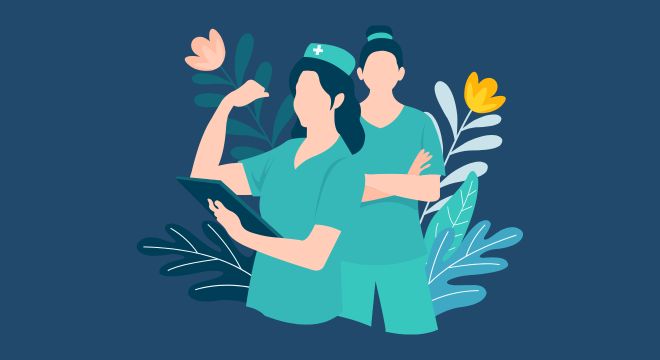Employee turnover is a persistent challenge in post-acute care, with rates often exceeding 50% annually according to the American Health Care Association (AHCA). High turnover negatively impacts daily operations, patient care quality, and staff morale, costing organizations both financially and operationally.
While traditional onboarding programs can help new employees acclimate—and potentially improve retention rates by up to 69% when done well—this approach often falls short of addressing the long-term needs of employees.
Enter continuous onboarding: an ongoing process designed to support, engage, and develop employees throughout their tenure. For post-acute care providers, adopting this approach could be a game changer.
What Is Continuous Onboarding?
At its core, continuous onboarding is about fostering a culture of learning and development. Much like a traditional onboarding process, new hires receive the initial training they need to meet your standards of care. But, unlike traditional methods, the learning journey doesn’t stop there. With continuous onboarding, team members are regularly provided with resources to enhance their skills throughout the employee journey, including ongoing training sessions, mentorship opportunities, and access to up-to-date resources.
By focusing on skill enhancement and professional development, continuous onboarding helps employees remain engaged and motivated while staying aligned with the latest industry standards. The results include better compliance, higher retention rates, and improved care quality. According to LinkedIn’s Workplace Learning Report, 94% of employees say they would stay longer at a company if it invested in their learning and development—a clear indication of the long-term benefits of continuous onboarding.
Key Elements of Continuous Onboarding
Many components that form the backbone of continuous onboarding may already exist in your organization. When strategically combined, these practices can have a transformative effect on employee satisfaction, retention, and overall organizational success.
Comprehensive Annual Training
While annual training is often a requirement set by federal and state regulatory agencies, it should be more than a box to check activity. According to research by Training Magazine, organizations that provide high-quality, industry-specific training see an average of 24% higher profit margins than those that do not.
To maximize the impact of your training program:
- Use content that directly addresses the needs of your caregivers by delivering practical skills and promoting behavior change.
- Ensure content resonates with real-world practices, making sure it aligns with the language and terminology of industry standards and a patient-centered approach.
- Provide personalized learning opportunities to individuals or teams based on competency results or survey findings.
- Go beyond requirements to provide educational materials that support employee well-being such as mindfulness training or stress management
- Align training with professional development goals, showcasing your dedication to their ongoing success.
- Support licensure requirements by offering access to Continuing Education (CE) courses or workshops that make learning more accessible and affordable.
Personalized and relevant training ensures staff feel equipped to succeed, fostering a sense of empowerment and competence.
Regular Feedback and Performance Evaluations
In the fast-paced world of post-acute care, regular feedback can often fall by the wayside. However, it’s critical for employee engagement and retention. Gallup research reveals that employees who have regular one-on-one meetings with their managers are three times more likely to feel engaged at work.
Tips for Effective Check-Ins:
- Weekly or biweekly meetings: Use these to recognize achievements, address concerns, and provide guidance on career growth.
- “Just-in-time” feedback: Offer immediate, actionable insights when issues arise to prevent minor problems from escalating.
- Goal alignment: Regularly review employee goals to ensure they align with organizational objectives, fostering a sense of purpose and belonging. Employees who work under managers who assist them in setting performance goals are 17 times more likely to be engaged.
These check-ins build trust, enhance manager-employee relationships, and promote a proactive approach to problem-solving.
Technology Integration
In today’s digital age, technology is the backbone of continuous onboarding. Tools like learning management systems (LMS) allow organizations to streamline processes by automating training delivery, tracking employee progress, and providing instant access to essential resources.
- Interactive Modules: Platforms like Showdme offer engaging, scenario-based modules that mimic real-life challenges.
- Mobile Accessibility: Given the shift-based nature of post-acute care, mobile-friendly training ensures employees can complete lessons anytime, anywhere.
- Data-Driven Insights: Use analytics to identify trends, such as areas where employees consistently underperform, and adjust training content accordingly.
Mentorship Programs
Pairing new hires with seasoned staff members provides invaluable guidance and accelerates the learning curve. It’s also good for retention. According to a study by the Association for Talent Development (ATD), organizations with formal mentoring programs experienced higher employee engagement and retention.
Mentorship programs create a support system for new employees while fostering collaboration and camaraderie—a vital element in high-stress post-acute care environments. As new hires become established employees, mentorships can evolve based on professional development goals. For example, if a CNA shows interest in working with dementia care patients, pair them with a tenured team member in that unit to give them a day-in-the-life preview of what working with these residents entails. This, paired with the right training, ensures employees can evolve and grow with your organization.
Opportunities for Growth
Continuous onboarding is not just about meeting minimum requirements—it’s about creating opportunities for advancement.
Surveys revealed that 71% of millennials view professional development opportunities as essential to their job satisfaction. Additional research shows that Gen Z, a growing portion of the workforce, also places a high value on career development.
Providing employees with access to additional certifications, role-specific workshops, or leadership training empowers them to take charge of their career trajectory. These growth opportunities also boost morale and create a workforce of motivated, high-performing individuals.
Implementing Continuous Onboarding in Your Organization
Adopting a continuous onboarding approach requires strategic planning and commitment. Here’s how to get started:
- Offer Personalized Learning Journeys: Learning is a core component of continuous onboarding. But to be effective, it can’t be one-size-fits-all. Work with your team members to develop learning journeys that support their role and ensure they are always equipped with the knowledge they need to confidently deliver high-quality care and service.
- Leverage Technology: LMS and eLearning platforms can streamline the delivery of training and education materials. Look for a vendor that offers courses specific not only to healthcare but your specific segment within post-acute care. This can ensure the materials are relevant and resonate with their day-to-day responsibilities.
- Foster Peer-to-Peer Learning: While many providers are moving annual training online, there is still plenty of room for in-person peer-to-peer learning. Ongoing mentorship programs are a great way for team members to experience hands-on learning. Team-based learning activities can also help extend education while also building camaraderie.
- Measure and Adapt: As with most initiatives, employee feedback is essential to success. Regularly collect feedback, make adjustments, and track metrics like training completion rates and turnover to measure success and identify areas for improvement.
Continuous onboarding is not just a trend—it’s a strategic investment that reaps long-term benefits for post-acute care providers. By fostering a culture of continuous learning and support, organizations can reduce turnover, improve compliance, and elevate the quality of care.
The transition to continuous onboarding requires effort, but the rewards—higher retention, increased job satisfaction, and improved patient outcomes—make it well worth the investment. For post-acute care providers ready to take the leap, now is the time to set the standard for excellence and innovation in care delivery.






